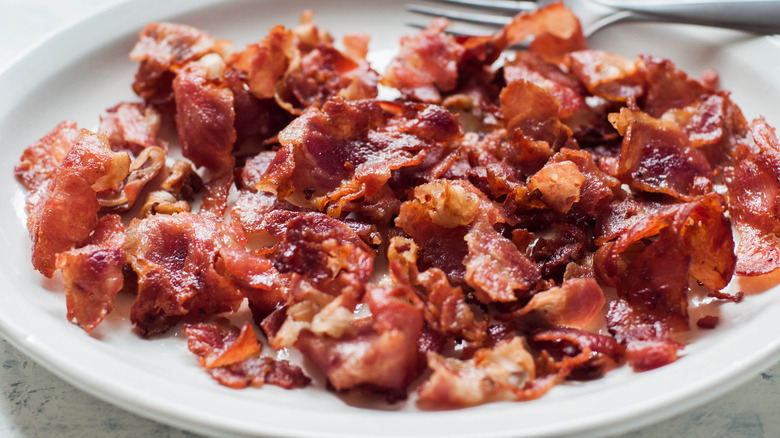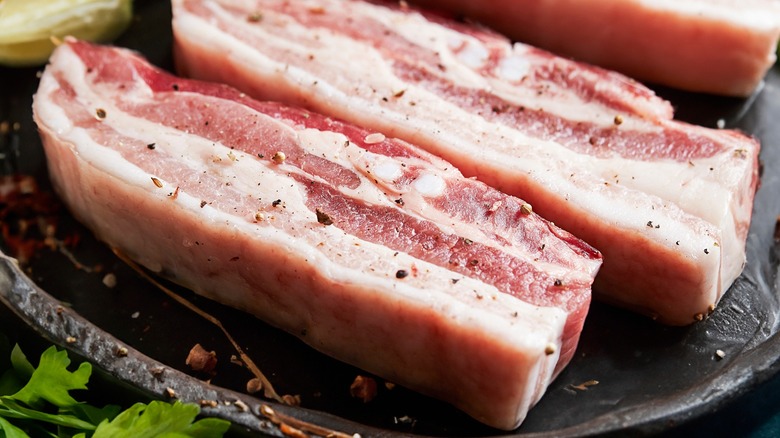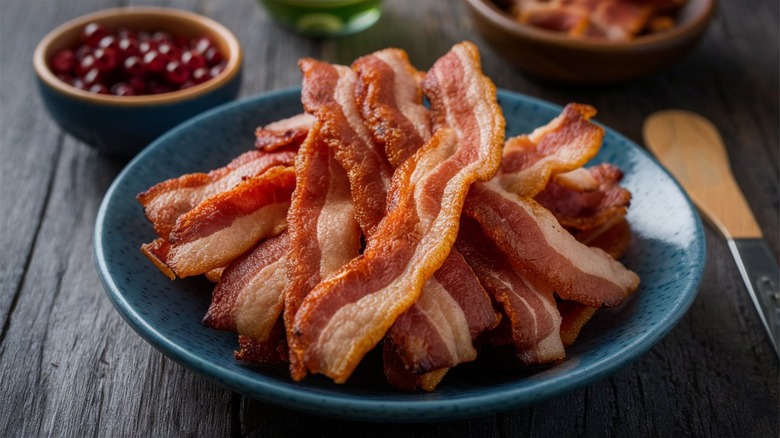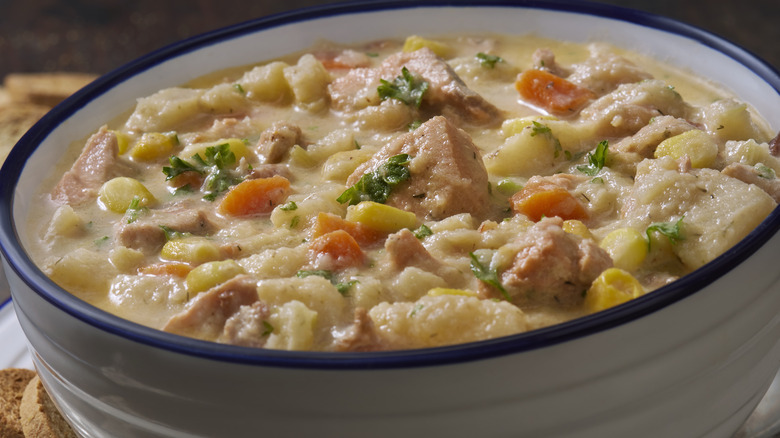Salt Pork Vs Bacon: The Distinct Difference Between The Two
Foodies love all types of cured meats, and as any preserved meat lover knows, these flavorful, dimensional morsels belong on more than just your charcuterie boards. When you think of "cured meats," gourmet options like prosciutto and soppressata might come to mind. But today, we're deep-diving into two "everyday" cured meats that folks might be overlooking — salt pork and American bacon — and unpacking what, exactly, makes these unique cuts different.
Both cuts come from the pork belly, though this shared origin hasn't awarded the meats the same degree of accessibility. Salt pork can be found in some grocery stores, but might require a trip to your local butcher shop to track down. By contrast, foodies would be hard-pressed to walk into a supermarket in America that doesn't stock bacon. We could also talk about their general vibes. Bacon is mainstream, while salt pork gives major "Little House on the Prairie" and Oregon Trail energy.
Today, it's a popular ingredient in the culinary styles of the American South and New England. Meanwhile, bacon has adopted an identity of its own with the bacon aesthetic trend that gripped the 2010s and the gastronomic emergence of bacon-wrapped everything. Vibes aside, the primary difference between bacon and salt pork is that bacon is smoked and salt pork is not. Bacon is also thin and crispy, whereas salt pork is typically cut into thicker pieces for a toothy, chewy bite.
What is salt pork?
Salt pork refers to pork belly or pork sides that have been heavily salted, which was once the go-to method of preservation before the advent of refrigeration. The large slabs of fatty meat are rubbed or packed in salt, or wet-brined in a salty liquid to cure before being cut into cubes or thick strips in different dishes. Thanks to its hardy shelf life and high fat and protein content, salt pork played a significant role in U.S. and European military rations from the 1600s through the 1800s.
Salt pork and hardtack also famously sustained soldiers during the American Civil War. The meat was historically a common choice for people on long-distance treks, such as sailors and traveling explorers. In fact, butchers used to sell cuts of meat that were considered less-desirable by turning them into salt pork. But the salt pork that foodies know and crave nowadays is less salty than the version that people would have been eating pre-refrigeration. Even so, to further dial back the saltiness, some choose to parboil their salt pork before incorporating it into their recipes.
What is bacon?
Bacon (aka streaky bacon, side bacon, or American bacon) is a high-fat, smoky cut of pork belly cured with a mixture of salt, nitrates and nitrites, and smoke. Depending on the flavor of the bacon, the brine also sometimes includes sugar. It features lengthy strips of fat that run parallel to the meat, and is typically cut into long, thin strips to sell. Much of this fat is rendered off when the bacon is cooked in the oven, skillet, or microwave, creating a taste that is simultaneously salty, sweet, and smoky. Variations like turkey bacon and meatless vegan bacon have emerged over time, as well as different flavors like black pepper-crusted, applewood, and maple bacon.
Bacon is an ultra-versatile ingredient, and is used to make everything from seafood-briney bacon-wrapped scallops to sweet-savory bacon jam. It's perhaps no surprise that the meat has enjoyed a centuries-old fanbase among foodies worldwide. Until the mid-1500s, the Middle English "bacoun" was used to refer to all cuts of pork. In 12th century England, a Great Dunmow church gave away an entire pork side to any husband who had not fought with his wife in a full year plus one day, hence the phrase "bring home the bacon." And in 1539, explorer Hernando de Soto of Spain brought 13 pigs to the New World, where wild pigs would run through the streets of New York until the mid-1800s. By the late 1800s, bacon was considered a fixture of international trade.
Bacon is smoked and crispy, while salt pork is meaty and not smoked
The chief difference between bacon and salt pork is that bacon is smoked and salt pork is not. This extra step is responsible for the signature smoky bacon flavor; salt pork tastes comparatively meaty and savory, but not smoky. Salt pork is also saltier than bacon, and it does not include nitrates or nitrites in the curing process. Another key difference between these meats is their shapes. Bacon is commonly sliced into thin crispy strips, whereas salt pork is typically toothier and is served in meaty cubes.
Salt pork usually comes sold in block form as a large slab, whereas bacon is pretty much always sold pre-sliced. In this way, salt pork is largely more similar to Italian pancetta or French lardons than to American bacon. Unlike pork chops or pork shoulder, bacon and salt pork aren't for eating as an entrée-style meat. These cured pork belly cuts are ultra fatty and salty, and as such, these ingredients are just as much about their protein-forward meatiness as about flavor-enhancing, like a condiment or spice — which brings us to the next difference between bacon and salt pork.
Salt pork is incorporated into recipes in chewy cubes, while bacon is eaten as crispy strips or crumbles
Salt pork makes a flavorful addition to vegetable or carbohydrate-rich dishes, and is often used for adding a salty, meaty taste and fatty richness to recipes like green beans or Brussels sprouts. Salt pork is also commonly cubed and added to soups, stews, or chowders as a flavorful, salty protein element. It's a fixture in potato and corn chowder, and it starred in President JFK's favorite dish, a traditional New England fish chowder from his childhood.
You could use salt pork to make warm and cozy baked beans, split pea soup, or Southern collard greens. When pan-fried, salt pork leaves behind flavorful fat renderings, which are then often used to make clam chowder or other creamy, hearty soups. Beyond these American regions, salt pork is a foundational ingredient in traditional arroz con tocino, Puerto Rican rice with salt pork. You could also use it in French quiche Lorraine or cassoulet, or a Chinese stir-fry.
Meanwhile, bacon is either served intact in strips or crumbled, and it's no secret that there are a myriad of bacon recipes beyond the classic American breakfast spread. Foodies use bacon to top cheeseburgers and sandwiches like the BLT or the classic New York City breakfast sandwich, the bacon, egg, and cheese, and it can be used to make a breakfast casserole or wrap a whole meatloaf. Bacon has even entered the dessert realm in sweet-savory creations like the maple-bacon donut and chocolate-covered bacon strips.




